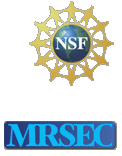Research Highlight #24:
Bioenabled Nanophotonics
Yeechi Chen, Keiko Munechika and David S. Ginger;
Department of Chemistry, University of Washington

Biological molecules such as oligonucleotides, proteins, or peptides can be used for the synthesis, recognition, and assembly of materials with nanoscale dimensions. Of particular interest are the fields of near-field optics and plasmonics. Many potential optical applications depend on the ability to control the relative positioning of organic dyes, plasmon-resonant metal nanoparticles, and semiconductor quantum dots with nanoscale precision. In this article, we describe some recent achievements in biological assembly and nanophotonics, and discuss potential uses of biological materials for assembling optically functional nanostructures. We emphasize the use of biological materials to build well-defined nanostructures for near-field plasmon-enhanced fluorescence.
Contact D. Ginger, for more details, ginger@chem.washington.edu.
MRS Bulletin, 33 536-542 (2008).



